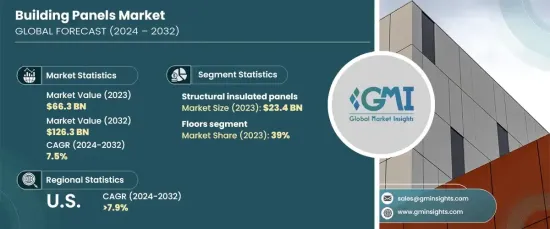
건축용 패널 세계 시장은 2023년에 663억 달러로 평가되었으며, 2024년부터 2032년까지 연평균 복합 성장률(CAGR) 7.5%로 성장할 것으로 예상됩니다.
이러한 강력한 성장은 특히 아시아태평양과 아프리카의 개발 도상 지역에서 도시화가 진행되고 있으며, 저렴한 가격으로 지속 가능한 건설 솔루션에 대한 수요가 급증하고 있는 것이 배경에 있습니다. 정부와 민간 개발자들은 비용을 절감하면서 주택과 상업시설의 건설을 간소화하기 위해 건축 패널에 대한 관심을 높이고 있습니다. 도시 인구의 확대에 따라 학교, 병원, 사무실 공간 등 현대적인 인프라의 필요성이 높아지고 있으며, 건축용 패널과 같은 내구성과 범용성이 뛰어난 재료 수요가 높아지고 있습니다.

건축용 패널 시장은 재료별로 콘크리트 패널, 목재 패널, 구조용 단열 패널(SIP), 진공 단열 패널(VIP) 등으로 구분됩니다. 그 중에서도 구조용 단열 패널은 2023년에 234억 달러의 수익을 창출하며 두드러진 성과를 보였습니다. 이 패널은 뛰어난 단열성과 높은 인기를 자랑하며 에너지 소비를 크게 줄이고 냉난방 비용을 줄입니다. 에너지 비용이 증가함에 따라 에너지 효율적인 건설 솔루션에 대한 주목이 높아지고 있으며, 구조용 단열 패널은 주택과 상업시설 모두에서 인기있는 옵션이되었습니다.
| 시장 범위 | |
|---|---|
| 시작연도 | 2023년 |
| 예측연도 | 2024년-2032년 |
| 시작금액 | 663억 달러 |
| 예측 금액 | 1,263억 달러 |
| CAGR | 7.5% |
설치 유형에 따라 시장은 바닥, 지붕, 벽 등으로 분류됩니다. 2023년에는 바닥 부문이 시장을 선도하여 39%의 점유율을 차지했습니다. 이 성장의 원동력이 되고 있는 것은 세계의 에너지 규제의 강화이며, 이것이 보다 높은 단열 및 방음 성능 기준을 충족시키는 재료의 채용을 촉진하고 있습니다. 바닥재용으로 설계된 건축용 패널은 단열성과 구조적 무결성을 모두 강화하는 능력으로 인기를 끌고 있습니다. 게다가 인공목재나 경량복합재 등 환경친화적인 재료의 인기가 높아지고 있는 것도 계속해서 시장 수요를 밀어 올리고 있습니다. 이 패널은 조립식 및 모듈형 건축에서도 매우 중요하며 대규모 프로젝트에서 조립 시간을 단축하고 비용 효율성을 향상시킵니다.
미국의 건축용 패널 시장의 2023년 수익은 132억 달러로 평가되었습니다. 2024년부터 2032년까지의 7.9%의 놀라운 연평균 복합 성장률(CAGR)로 성장할 것으로 예상됩니다. 도시화와 단독주택 및 집합주택 수요 증가에 추진된 강력한 주택시장이 주요 성장 요인이 되고 있습니다. 팬데믹 후의 교외 확대와 리폼 동향은 에너지 효율과 내구성이 뛰어난 건축 패널의 채용을 더욱 가속화하고 있습니다. 게다가 국내 각지의 인프라의 노후화가 리폼 활동을 활성화시켜 현대적이고 미관이 뛰어난 기능적인 재료에 대한 수요를 높이고 있습니다.
The Global Building Panels Market was valued at USD 66.3 billion in 2023 and is projected to grow at a CAGR of 7.5% from 2024 to 2032. This robust growth is driven by rising urbanization, particularly in developing regions across Asia-Pacific and Africa, where demand for affordable and sustainable construction solutions is surging. Governments and private developers are increasingly turning to building panels to streamline residential and commercial construction while reducing costs. As urban populations expand, the need for modern infrastructure-such as schools, hospitals, and office spaces-is fueling the demand for durable and versatile materials like building panels.

The building panels market is segmented by material into concrete panels, wood panels, structural insulated panels (SIPs), vacuum insulated panels (VIPs), and others. Among these, structural insulated panels stood out, generating USD 23.4 billion in revenue in 2023. These panels are highly sought after for their superior thermal insulation properties, which significantly reduce energy consumption and cut heating and cooling expenses. With energy costs rising, there is an increasing focus on energy-efficient construction solutions, making structural insulated panels a popular choice in both residential and commercial buildings.
| Market Scope | |
|---|---|
| Start Year | 2023 |
| Forecast Year | 2024-2032 |
| Start Value | $66.3 Billion |
| Forecast Value | $126.3 Billion |
| CAGR | 7.5% |
Based on installation type, the market is categorized into floors, roofs, walls, and others. In 2023, the floors segment led the market, capturing a substantial 39% share. This growth is fueled by tightening global energy regulations, which are driving the adoption of materials that meet higher thermal and acoustic performance standards. Building panels designed for flooring are gaining traction for their ability to enhance both insulation and structural integrity. Additionally, the rising popularity of eco-friendly materials-such as engineered wood and lightweight composites-continues to boost market demand. These panels are also pivotal in prefabricated and modular construction, delivering faster assembly times and cost-efficiency for large-scale projects.
The U.S. building panels market generated USD 13.2 billion in revenue in 2023 and is expected to grow at an impressive CAGR of 7.9% from 2024 to 2032. The strong housing market, fueled by urbanization and increasing demand for single-family and multi-family homes, is a key growth driver. Suburban expansion and renovation trends in the post-pandemic era have further accelerated the adoption of energy-efficient and durable building panels. Moreover, aging infrastructure in various parts of the country has intensified renovation activities, increasing the demand for modern, aesthetically appealing, and functional materials.